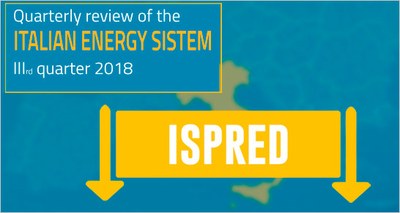Energy: Consumption slows down, electricity prices for families at the highest levels over the last 10 years
10/1/2019
ISPRED Index (Security, PRices, Decarbonisation) worsens still, according to the ENEA quarterly Analysis
 In the third quarter of 2018, electricity prices for Italian households reached the peak of the decade, while there were double-digit increases (+ 10%) for medium-sized companies. In addition, energy consumption slowed down: + 1% as compared with + 3.2% in the first half of the year. This is according to data provided by the ENEA Energy System Quarterly Analysis, which reports a 5% decline in the index ISPRED [1], the eighth consecutive quarterly deterioration.
In the third quarter of 2018, electricity prices for Italian households reached the peak of the decade, while there were double-digit increases (+ 10%) for medium-sized companies. In addition, energy consumption slowed down: + 1% as compared with + 3.2% in the first half of the year. This is according to data provided by the ENEA Energy System Quarterly Analysis, which reports a 5% decline in the index ISPRED [1], the eighth consecutive quarterly deterioration.
"The cause, this time, is the increase in final prices driven by energy commodities, with a surge in prices of natural gas (+ 60%), the electricity exchange (+ 33.5%) and Brent oil, which in October reached $ 85 per barrel. The effects of the subsequent sharp drops in crude oil, now at $ 55, and to a lesser extent in gas, are likely to manifest only in the upcoming months ", Francesco Gracceva, the ENEA expert who coordinated the Quarterly Analysis, pointed out.
The analysis shows that Italian companies pay higher prices than the EU average, with the exception of large companies: a medium-small company with an annual consumption of 1.250 MWh, spends for electricity approximately 70 thousand euro a year more than a French competitor of similar size and approximately 30 thousand more than a British or a Spanish.
As regards decarbonisation , CO2 emissions were down 0.5% as compared with the same period of 2017, and about one point in the first nine months of the year. However, our Country suffers from a further loss of competitiveness of low-carbon technologies in strategic sectors like electric mobility and renewables. In the sectors of electric vehicles and lithium-ion batteries, for instance, the negative balance with foreign countries was of 155 million euro in 2017 and 165 million euro in the period January-August 2018, while for photovoltaic was of 137 million euro in 2017 and 139 million euro in the first eight months of 2018. Italy, on the other hand, is a net exporter of wind energy and solar thermal energy, even if their contribution to the trade balance is not particularly significant, considering the minor impact on global trade.
As for security, the ENEA Analysis shows a substantial stability even if it doesn’t rule out possible critical issues for electricity and gas in case of extreme events during the winter season. "The only partial availability of interconnection with Northern Europe makes it difficult for the gas system to comply with the security rule N-1 [2], in a scenario conditioned by the growth of Asian demand and the increasingly strategic role of Russian gas (particularly the one exported through the Ukrainian route), which in the third quarter of the year accounted for 50% of the national imports, " Gracceva said.
"The analyses of the European association of gas network operators ENTSOG tend to exclude the risk of supply disruptions, but in case of demand and/or supply shocks, a scenario of high price volatility is also plausible. Furthermore, according to the European association of electricity grid operators, ENTSO-E, there could be problems with the suitability of the electricity system at times of high demand and low renewable energy generation ", Gracceva concluded.
[1] Index ISPRED (Security, PRices, Decarbonisation) measures energy security, prices and decarbonisation trends of the Italian Energy System.
[2] The indicator N-1 shows the capability of the gas sytem to meet the daily peak demand in case of failure of the main import infrastructure on an exceptionally high peak-day
